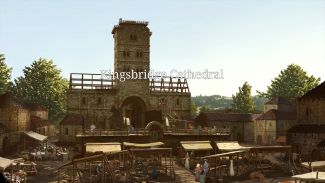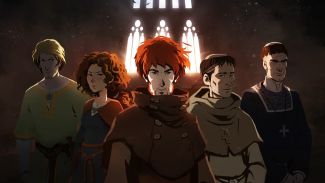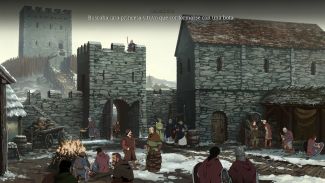The Pillars of the Earth is, above all, one of the best historical fiction novels in literature. It’s one of those stories that somehow everyone has read. This is, in my opinion, one of those novels that is already part of the collective imagination, like Da Vinci Code, or the stories of Harry Potter. In case someone was missing who did not know the plot, a television adaptation was made in 2010 and, finally, the video game that concerns us today. In the case of the title, it went on sale for PC, PS4, and Xbox One in 2017. A year later it was re-released for iPhone and a few weeks ago it got a slight remaster for Nintendo Switch. A game that in its time happened without too much noise that today we can give a second chance.
The story that the stones sing
First of all, it’s important to point out something: it’s a very quiet game. This is not a negative slow, but the one needed to make a stew over low heat. This takes us into a universe between the graphic adventure and the very beautiful interactive novel. A character who will sometimes be difficult to digest for the most impatient players, but a real treat for those most accustomed to this type of genre.
As in the novel, the stories of the characters evolve little by little, culminating, like the cut stones of a pillar, in the key of the vault. The story interweaves the passions and dreams of a series of people who masterfully converge on something beautiful and common, a goal capable of the worst and the best. And that’s what The Pillars of the Earth is about, not the story of this or that character, or saving this or that country, it’s about the lives of kingsbridge cathedral, who is the true protagonist of this story. Each of the characters we deal with is intimately linked to the construction of the magnificent edifice, some captured by their beauty, others by their destiny.
Advertisement:
In the game (and the novel that preceded it, of course), building the cathedral is just the perfect excuse to tell the real story. We are before a perfect reflection of English society in the twelfth century. Troubled times after the turn of the millennium, still very sensitive to apocalyptic fears. The mood is that of the devil behind men’s evil deeds, passions and fears. In the game we will be able to live in our flesh the life of a monastery, the convulsive feudal wars and, above all, the construction of cathedrals. These were the confusing times when the Romanesque began to give way to the Gothic in the construction of churches. We will have to take into account all these feelings, because in Los Pilares de la Tierra we will also have to decide.
A game system from the time of the cathedrals
The decision system is implemented in the game and each end of the chapter will remind us of the actions we have carried out. The weird thing is that we already know the novel’s ending (or at least we know there is), so it might be weird that there could be a different option than the canonical ending. The secret is very simple, there are no changes, or at least not very different. One way or another, despite small variations, we will find ourselves in situations very similar to those that occurred in the book.
Mechanically, aside from the decision system, the game can be boring and tedious. In short, this is a format that we had seen in other games for years and which does not add anything. A system Point and click which does not innovate and even feels overwhelmed. It’s a shame, because, for players who haven’t sympathized with the story, the playable system will hardly captivate them. The biggest difficulty lies in a button-press system that’s notoriously easy when the story needs you to beat it.
Advertisement:
In fact, the most interesting situations occur at very specific times when characters are moving long distances across the map. In these moments, the game changes slightly, adopting a bullet format in which the situation is described and a decision that we must make quickly before a counter runs out. These decisions will have immediate consequences on the future of our character.
As we have already mentioned, the most important basis of the game is its narration and dialogues. The story is definitely its backbone, which is why it lacks the system they chose in the dialogue format in Daedalic. Texts in both conversations and descriptions appear on heads and objects, without any type of frame or interface to identify words in characters. A confusing and tedious system, especially if you think of the number of lines of dialogue that we will see appear throughout the adventure. As is the case with many games of this type, observation within the actions eventually becomes useless and repetitive, so we will end up only using the interact button, except in very specific cases.
lights and shadows
In its visual and artistic section, The Pillars of the Earth knows how to do things well. The game explores different settings, from lonely forests to bustling cities, and feels real and immersive at all times. Outstanding work is the use of clever shots and the play of light to create memorable scenes in line with the epic that accompanies the story. The use of color is elegant and subtle, making us feel at all times in time.
Also, the soundtrack, ambient sounds and vocals are at an incredible level. The languages between which we can select the voices are English and German, being able to select the language in the subtitles. A little slap on the wrist is taken by the accessibility section, since it sucks. There is no possibility to change the appearance of subtitles or texts.
As far as performance goes, the Nintendo Switch is more than ready to handle a game of this caliber, and other than a few character and character flickers, we didn’t encounter any issues.
In short, The Pillars of the Earth loses the opportunity to become a sublime game. The novelties it introduced in its first release still look fresh and modern, but the core of the game remains archaic. The designs are beautiful, but they hide tired and simple animations. And finally, the story is beautiful, told through a lousy aspect ratio. The end is a cathedral which remains standing, but which will not go down in history.




